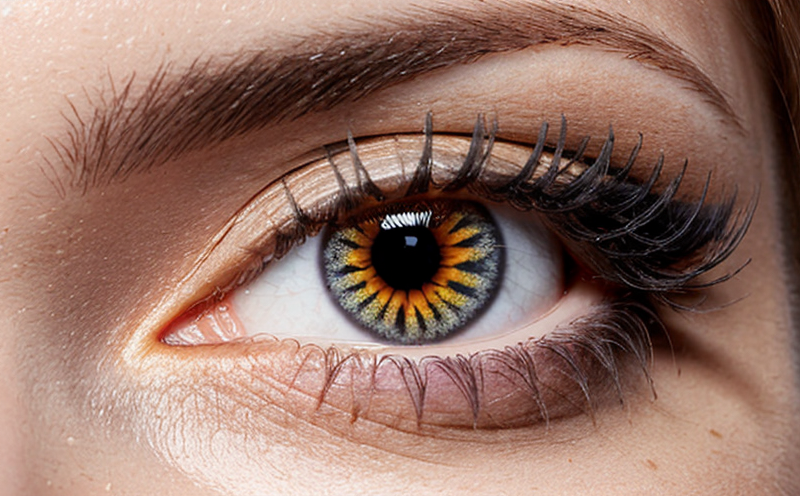Safety Testing of Lash Tinting Cosmetic Products
When it comes to lash tinting cosmetic products, ensuring safety and efficacy is paramount. These products are designed to enhance the appearance of eyelashes by providing a temporary color effect that can last for several days. However, the pigments used in these products must be carefully evaluated to ensure they do not cause irritation or adverse reactions when applied to sensitive ocular surfaces. This service focuses on conducting comprehensive safety testing to identify potential hazards and ensure compliance with international standards.
The primary focus of this service is to assess the potential for eye irritation, which can arise from various factors including the pigments themselves, preservatives used in the formulation, or other additives. The tests are designed to simulate real-world conditions under which consumers might use these products, thereby providing a reliable assessment of safety.
The testing process involves several critical steps that ensure thorough evaluation. Specimen preparation is crucial and involves creating test samples that closely resemble the actual product formulations. This includes using appropriate solvents and ensuring that the concentration of active ingredients matches those found in commercial products. The testing apparatus used is highly sophisticated, designed to replicate the ocular environment as accurately as possible.
The first step in this process is the preliminary examination of the formulation for any known irritants or allergens. This includes a review of the ingredient list against databases of known toxic substances and allergens. If any such ingredients are identified, further investigation into their concentration and potential impact on ocular health is conducted.
Following this, the actual irritation testing begins using standardized protocols. These tests typically involve exposing human corneal cells or rabbit eyes to the product under controlled conditions for a set period. The response of these cells or tissues is then evaluated for signs of inflammation, redness, or other indicators of irritation. This allows us to determine the safe concentration levels of the product that would not cause harm.
In addition to direct ocular exposure tests, we also conduct systemic toxicity testing where applicable, ensuring a comprehensive assessment of any potential risks associated with prolonged use of these products. These tests are conducted in strict accordance with international standards such as ISO 10993-10:2016 and ASTM F854.
The results of these tests are meticulously documented and reported, providing clear insights into the safety profile of the lash tinting cosmetic products. This data is invaluable for quality managers, compliance officers, R&D engineers, and procurement teams who rely on it to make informed decisions about product development, labeling, and regulatory submissions.
Scope and Methodology
| Test Step | Description |
|---|---|
| Preliminary Examination | A review of the formulation for known irritants or allergens. |
| Ocular Exposure Testing | Exposure of human corneal cells or rabbit eyes to the product. |
| Systemic Toxicity Testing (if applicable) | Evaluation for potential risks associated with prolonged use. |
Quality and Reliability Assurance
The quality assurance process in our laboratory is rigorous and designed to ensure that every test conducted meets the highest standards of accuracy and reliability. Our team of experts adheres strictly to international guidelines, ensuring that all tests are conducted under controlled conditions that mimic real-world scenarios as closely as possible.
Our state-of-the-art equipment and highly trained personnel guarantee consistent and reliable results. We employ advanced analytical techniques to detect even the smallest trace elements in the formulations, which can have significant impacts on safety outcomes. This level of precision is crucial for ensuring that the products meet not only regulatory requirements but also exceed them.
We invest heavily in regular calibration and maintenance of our instruments to prevent any potential errors or inaccuracies. Additionally, we conduct internal audits regularly to ensure that all processes are followed correctly and consistently. The results of these audits are reviewed by our quality assurance team, who provide feedback to improve the testing process further.
Our commitment to excellence extends beyond just meeting standards; it includes continuous improvement through ongoing research and development. We stay updated with the latest advancements in laboratory practices and incorporate them into our routine operations whenever possible. This ensures that we remain at the forefront of safety testing, providing clients with the most accurate and reliable data available.
Environmental and Sustainability Contributions
In today’s environmentally conscious world, it is essential for laboratories to also consider their impact on the environment. Our laboratory takes proactive steps to minimize its ecological footprint while maintaining high levels of efficiency and productivity.
We employ energy-efficient equipment and practices that reduce waste generation during testing procedures. Wherever possible, we use sustainable materials in our packaging and operations to further reduce environmental impacts. Additionally, we have implemented recycling programs for hazardous waste generated from our tests, ensuring proper disposal and minimizing harm to the environment.
Our commitment to sustainability does not stop there; it also includes fostering an awareness of ecological responsibility among our staff members through regular training sessions. By promoting a culture of environmental stewardship within the organization, we aim to contribute positively towards global efforts aimed at reducing carbon footprints and protecting natural resources.





